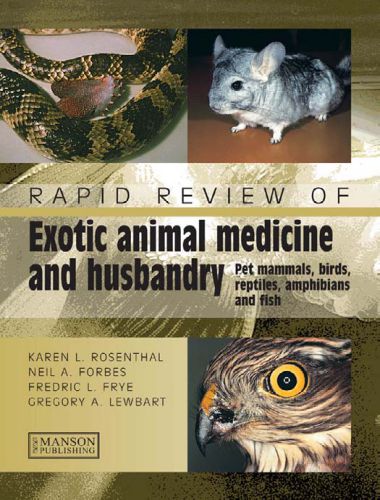Rapid Review of Small Exotic Animal Medicine & Husbandry by Karen L Rosenthal; Neil A Forbes; Fredric L Frye; Gregory A Lewbart.
Rapid Review of Small Exotic Animal Medicine & Husbandry

The book is divided into four sections – small mammals, birds, reptiles/amphibians, ornamental fish – and consists of an introduction to the essential aspects of medicine and husbandry of each group of animals, 400 colour-illustrated clinical cases, plus summary questions to highlight key points.The cases are a blend of the more common and especially interesting conditions, and cover clinical presentation, aetiology/pathogenesis, investigation, diagnosis.
The authors have provided a quick guide for the busy general veterinary clinician to use. [They] should be commended on putting together this useful text for the ever-growing veterinary interest to treat exotic animals.
A fun and interesting way to learn about these species, and provides pithy and accurate, up to date assessments of most of the common conditions and problems that will present in this diverse group of animals. It should be a welcome addition to the book shelf of those dealing with exotic animals.
This is a useful self assessment resource for experienced and novice practitioners caring for exotic animal pets Will provide veterinarians with a quick, case-based reference with pictures to help guide them towards more information or even to rule out diseases and husbandry issues.
This format was very well received. So well received in fact that demand dictated a book for each group of exotic animals seen in practice. Two decades ago, this was fine. However, this is no longer fine. The trend among organized veterinary exotic animal associations and journals is to consolidate rather than split. Many association meetings include more than one group of exotic animal presentations. Many colleagues do not see just avian or reptile patients, but wish to see all exotic patients.
Clients would prefer to visit a veterinarian who can deal with all their exotic patients rather than visit someone who specializes in birds and someone else who specializes in reptiles. Sadly, our university system, in general, still lacks the resources to teach many of their veterinary students about exotic animal patients. For most newly graduated veterinarians, the ability to help these patients is a ‘live and learn’ process.
This is not ideal for the patients and can be discouraging to fledgling veterinarians. This book was born in an effort to revive the successful format followed in the self-assessment series and to satisfy the appetite of all veterinarians who wish to learn more about exotic patients. We hope these pages will prove useful in the treatment of these wonderful patients.
| PDF Size: 28 MB | Book Download Free |
Password: pdflibrary.net
